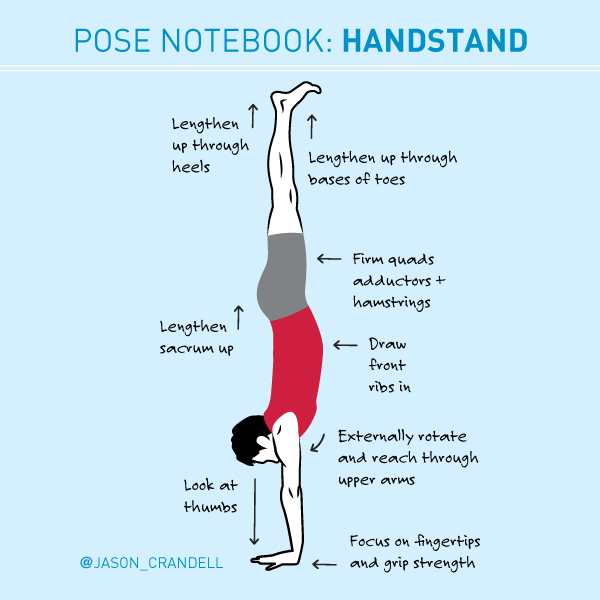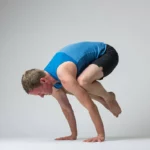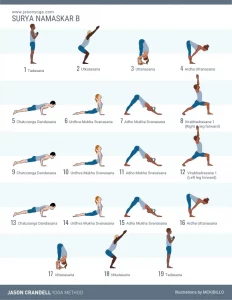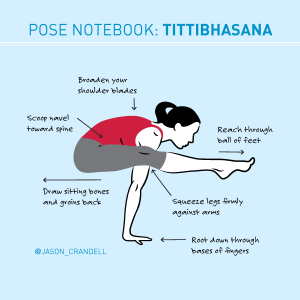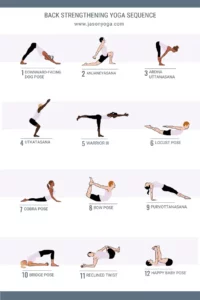Handstand is the darling of the social media world for good reason. The posture conveys strength, focus, and all-around physical aptitude. It also makes for a good photo opp in a bustling city center, or on a pristine beach, or anywhere else you want to capture a “yoga moment” and ensure your participation in today’s yoga zeitgeist.
Of course, Handstand is not just a photo opp or a boastful trend. It’s a time-honored, established inversion that’s taught in multiple lineages. Whether you’re proficient in this pose or just starting your inversion journey, Handstand requires 100 percent of your attention while you’re practicing it. You may find that your attention wanders to your “to do” list in Savsasana or sometimes you’re not fully focused in Warrior II. But, have you ever thought about what kind of sandwich you’re going to have for lunch while working on Handstand? No, you haven’t. You’re fully present and engaged with the present moment when you’re practicing Handstand. That’s yoga.
WARM UP
If you’re a seasoned practitioner and Handstand is a regular part of your practice, you will need very little warm-up. In fact, Handstand is a great first or second pose in a sequence for students who are proficient in this posture. If you’re a little newer to this posture or need a slower build-up, you can prepare for Handstand with shoulder openers that open your upper back and spread your shoulder blades like Garudasana and Cat Pose. Shoulder openers that stretch your triceps and lats, such as Half-Dog (also called “Puppy Pose”) and Gomukhasana are great. Since Navasana, Ardha Navasana, and Forearm Plank engage your core, they are also good preparations for Handstand.
HOW TO TEACH HANDSTAND + HANDSTAND PRACTICE TIPS
Practitioners need to learn this pose at the wall, often with the help of a skilled teacher, long before they indulge their “press into Handstand in the middle of the room” fantasy. I’m going to write an article on pressing into Handstand at a later date, but here I will assume that you’re working at the wall.
1. Set up in Downward Facing Dog with your hands six inches from a wall.
2. Step one foot half way to your hands and bend your knee. Choose whichever leg feels the most natural.
3. Bring your shoulders forward so that they’re direclty abover your wrists. Root down through the base of each finger and thumb, straighten your elbows, and slightly externally rotate your upper arms.
4. Look at the floor in between your hands. Take a slow, deep breath. Don’t freak out.
5. As you exhale, bend the knee that you stepped forward more deeply and strongly push the floor away. As this leg jumps, simultaneously swing the other leg toward the wall. Keep the knee of your “swinging” leg straight.
6. As one leg swings toward the wall and the other leg jumps, draw your navel toward your spine to recruit your core muscles and create greater lift.
7. You need to use enough strength and momentum to get your hips over your shoulders. Once your hips are above your shoulders, your “swinging” leg will make it to the wall and stay there. At this point, you can bring your second leg (your “jumping” leg to the wall).
8. Now that you’re in the pose, you can refine it with the instructions on the infographic above!
9. Hold the pose for a few seconds before slowly lowering one of your feet toward the floor. As you lower one leg, the second will follow shortly thereafter.
10. Spend a few moments in Child’s Pose or a standing forward bend.
See also Handstand Sequence
IF I CAN’T DO HANDSTAND YET, WHAT SHOULD I DO INSTEAD?
Well, if you’re in class you can take your pretend bathroom break. Right? But, if you’re struggling with Handstand and you really want to develop this pose, you can work on the following:
1. Focus on building shoulder strength and confidence with Dolphin Pose or Half Handstand with your feet on the wall.
2. Focus on building core strength by practicing Forearm Plank, Navasana, and Ardha Navasana.
3. Repetition is key! It takes practice to get into Handstand. So, one option, is to simply focus on the action of kicking into Handstand without actually getting all the way there. Repeat the process of swinging, kicking, and hopping several times to build your understanding and coordination of this process.
PART II: ANATOMY AND SEQUENCING FOR HANDSTAND
WHICH MUSCLES DOES HANDSTAND STRENGTHEN?
Your legs
If you touch someone’s legs in Handstand, you’ll notice that the leg muscles are firm active in this pose. That said, the most notable exertion comes from the inner leg muscles, the adductors. Engaging these muscles helps both legs work together and access your core, which creates better control in the pose. Your quadriceps are also working to lengthen your legs and keep your knees straight. And your hamstrings engage to help your hips extend.
Your core
Your core’s primary job in Handstand is to keep your pelvis, ribs, and lower spine aligned and prevent hyperextension in your lower back. Specifically: your psoas and illiacus helps your legs stay vertically aligned and your transversus abdominus and obliques help keep your lower back from hyperextending.
Your spinal muscles
Your erector spinae are working to help maintain the vertical position of your spine and balance the muscular forces of your core.
Your shoulders and arms
While your legs, core, and spine work to maintain the position of your entire body, your shoulders and arms have the greatest amount of work in Handstand. Your deltoids have the biggest job since they keep your shoulders flexed. They’re supported by the rotator cuff muscles which help maintain the alignment of the upper arm. Your triceps also have the challenging job of keeping your elbows straight. Your serratus anterior muscles laterally rotate and firm your scapulae against your ribs. Lastly, your forearm and hand muscles work to support balance in the posture.
WHICH MUSCLES DOES HANDSTAND STRETCH?
Your latissimus dorsi
Handstand doesn’t particulary stretch the body. Sure, it stretches one’s sense of themselves, one’s confidence and so on. But, as far as the body is concerned, the lats are really the only muscles that stretch in this pose. And, truthfully, they’re only going to stretch if they’re relatively tight–and, even then, it’s mild.
SEQUENCING FOR HANDSTAND
You can find a fully-illustrated, 16-pose sequence for Handstand here.
{illustration by MCKIBILLO}
